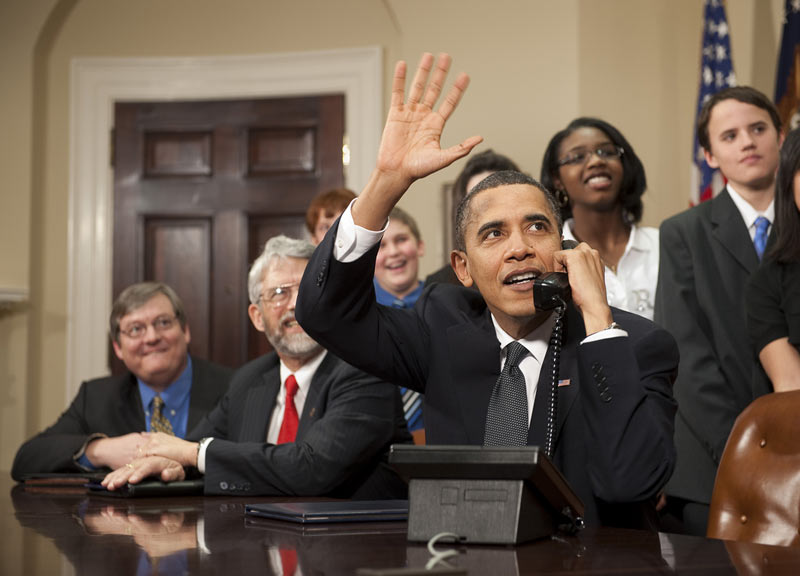NASA's New Direction: FAQ

Confusion abounds on President Barack Obama's new plan forNASA. Here are some frequently asked questions and their answers:
What does the plan entail?
The newdirection for NASA, as proposed by President Obama, was announced as partof the administration's 2011 budget request. Under the plan, NASA would cancelthe existing Constellation program, which aimed to build Ares I and Ares Vrockets to carry astronauts aboard a spacecraft called Orion back to the moon.
Instead of Constellation, President Obama suggested NASA aimto take humansto an asteroid by 2025 and then on to Mars by the mid-2030s.
The President also proposed extending the InternationalSpace Station, which was set to be decommissioned in 2016, through 2020.
To carry astronauts to the station after the space shuttlesare retired at the end of 2010 or beginning of 2011, the new proposal wouldrely on Russian Soyuz spacecraft and new privateU.S. spaceships yet to be built. Meanwhile, NASA would focus its energieson designing a heavy-lift rocket capable of traveling beyond low-Earth orbit todestinations including an asteroid and Mars.
Is this plan definitely going to happen?
Get the Space.com Newsletter
Breaking space news, the latest updates on rocket launches, skywatching events and more!
Not necessarily. The proposal must be approved by Congressas part of its overall decision in response to the President's 2011 budgetrequest. Until the request is approved, NASA is restricted under law to outrightcancel any part of Constellation without Congressional permission.
Did President Obama cut NASA's funding?
Actually, the new plan calls for $19 billion in funding forNASA in 2011, a slight increase from the $18.3 billion it was allotted in 2010.The President also asked for an extra $6 billion over five years to supportcommercial spaceships to launch NASA astronauts into space.
Does the new plan cancel the space shuttle?
NASA's fleet of three space shuttles ? Discovery, Endeavourand Atlantis ? has been slated to retire this year since as far back as 2004.The decisionto retire the shuttles was made following the Columbia accident as part ofthe Constellation plan, under the administration of George W. Bush.
Is NASA getting out of the human spaceflight business?
A common misconception about the new plan is that PresidentObama wants NASA to hand off the business of flying people to space to theprivate sector.
In fact, the new plan aims to hand off the job of flyingpeople to low-Earth orbit to commercial companies. But that would allowNASA to focus on building spaceships to carry humans beyond Earth orbit, to anasteroid, Mars or beyond, the President has said.
Can we eliminate the gap in U.S. human spaceflightability?
After the shuttlesare grounded for good, America will be left with no independent means oftransporting humans to space. This gap has been foreseen since the 2004decision to retire the space shuttles, because the Constellation ships toreplace them wouldn't have been ready by 2010 even if that program had been onrunning schedule.
The Obama administration hopes the gap will be narrowed bythe arrival of a private U.S. spacecraft capable of ferrying astronauts toorbit. Companies like SpaceX, which recently launched its Falcon 9 rocket on asuccessful first test flight, and Orbital Sciences, are aiming to fill thatneed.
In an April 15speech at Florida's Kennedy Space Center in April, President Obamaannounced a 2015 deadline for NASA to decide on a rocket design for aheavy-lift vehicle to carry astronauts beyond low-Earth orbit to an asteroid,Mars and beyond.
Are any elements of Constellation to be saved?
In his April speech, the President also announced a plan torevive the Orion capsule, an element of the Constellation architecture, to beused as a lifeboat for astronauts to escape the International Space Station inan emergency.
Under the plan, NASA would continuedeveloping Orion, albeit in a stripped-down form from its originalconception as a manned craft for launches to and from space. Now Orion won't bedesigned to lift off with crew onboard, but it could be launched unmanned anddock at the station to transport astronauts back to Earth if needed.
Where did the new plan come from?
In 2009, President Obama appointed an independent panel ofexperts, including former astronauts and industry leaders, to review NASA'splans. That panel, called the Augustine committee after its chairman NormanAugustine, former CEO of Lockheed Martin, found that the Constellation planwould be unable to reach its goals given the agency's current funding levels.
The committee offered several paths to go forward that thenew plan borrows heavily from.
Others have seen earlier precursors of the plan in a reportissued in 2004 by a team led by Wesley Huntress, a former NASA associateadministrator for space science.
- Misperceptions Swirl Around Obama Space Plan
- Video Show - NASA's Vision for Humans in Space
- NASA's Most Memorable Space Missions
Join our Space Forums to keep talking space on the latest missions, night sky and more! And if you have a news tip, correction or comment, let us know at: community@space.com.

Clara Moskowitz is a science and space writer who joined the Space.com team in 2008 and served as Assistant Managing Editor from 2011 to 2013. Clara has a bachelor's degree in astronomy and physics from Wesleyan University, and a graduate certificate in science writing from the University of California, Santa Cruz. She covers everything from astronomy to human spaceflight and once aced a NASTAR suborbital spaceflight training program for space missions. Clara is currently Associate Editor of Scientific American. To see her latest project is, follow Clara on Twitter.









